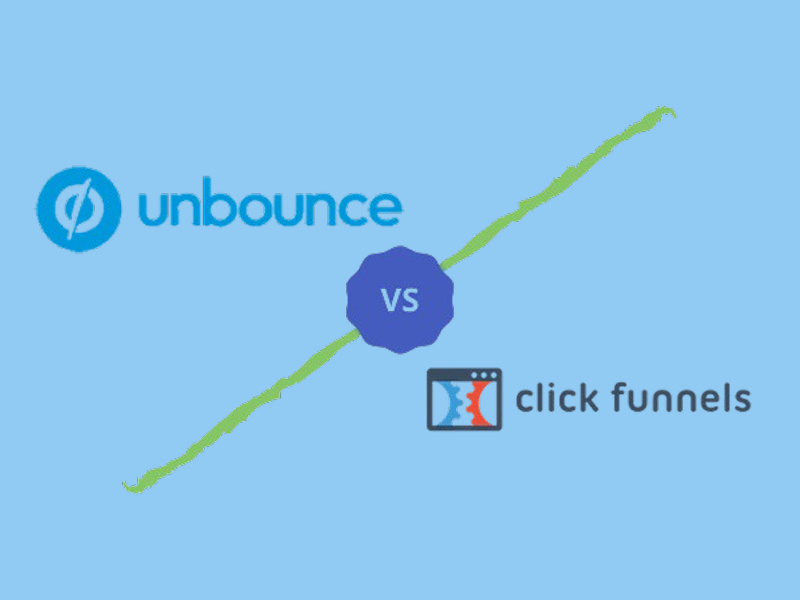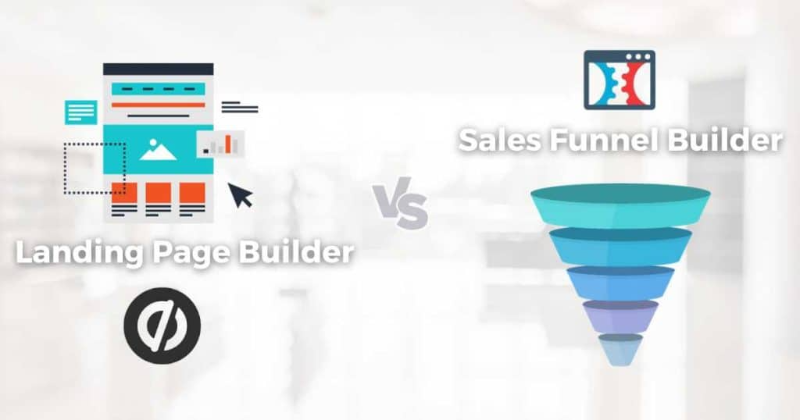
Building high-converting landing pages and efficient sales funnels is no small feat, and choosing the right tool can be a game-changer for your business success . Two of the most popular platforms in this space—Unbounce and ClickFunnels—promise powerful features, but which one truly aligns with your needs and goals?
Here’s an in-depth Unbounce vs ClickFunnels step-by-step comparison where we break down their features, pricing, and strengths to help you make the best decision for your business.
Both Unbounce and ClickFunnels are designed for marketing professionals who prioritize increasing conversions.
Unbounce shines in creating clean, professional landing pages with an intuitive drag-and-drop editor and extensive template library. On the other hand, ClickFunnels is an all-in-one sales funnel suite equipped with tools for email marketing, membership sites, and more.
Unbounce is generally more beginner-friendly with faster onboarding and immediate usability. ClickFunnels, while highly feature-rich, has a steeper learning curve but offers tools for building complete sales funnels, making it ideal for businesses heavily focused on automated sales processes.
Unbounce is a powerful landing page builder designed with marketers in mind. Its mission? To help you create pages that convert visitors without requiring a developer.
Smart Builder with AI
Leverage AI to streamline your page-building process with pre-optimized suggestions.
Dynamic Text Replacement
Personalize copy dynamically for PPC campaigns for improved relevance and conversions.
AMP Landing Pages
Deliver lightning-fast mobile experiences to keep your growing mobile audience happy.
Comprehensive Analytics
Gain insights into visitor behavior, enabling real-time optimization.
Advanced Integrations
Plug in your favorite tools like CRM platforms and email software seamlessly.
| Plan | Price | Features |
| Build Plan | $99/month | Unlimited pages and 20K traffic volume |
| Experiment Plan | $149/month | Adds unlimited A/B testing and higher traffic volumes (up to 30K) |
| Optimize Plan | $249/month | Includes AI-driven traffic optimization |
| Concierge Plan | $649/month | Custom features for larger teams and traffic volumes |
| Pros | Cons |
| ✅ Effortless drag-and-drop interface | ❌ Higher tiers can get pricey |
| ✅ Beautiful and conversion-focused templates | ❌ Limited for complex sales funnels |
| ✅ Built-in A/B testing | |
| ✅ Excellent customer support |
ClickFunnels is your all-in-one solution for building complete sales funnels. It combines landing pages, email marketing capabilities, and additional tools into one streamlined platform.
Sales Funnel Builder
Create multi-step funnels that guide users through every stage of your sales process.
A/B Testing
Easily compare versions of your campaigns to identify what works best for conversions.
Membership Sites
Set up subscription-based content without requiring additional tools.
Share Funnels
Collaborate efficiently or explore monetization opportunities by sharing funnel designs.
Website Hosting
Host your pages directly on ClickFunnels for ultimate simplicity.
| Plan | Price | Features |
| Startup Plan | $97/month | 3 brand workspaces and unlimited funnel-building capabilities |
| Pro Plan | $297/month | Up to 10 brand workspaces and additional team integrations |
| Pros | Cons |
| ✅ Complete sales funnel creation in one platform | ❌ Steep learning curve |
| ✅ Active and supportive user community | ❌ Higher pricing, especially for small businesses |
| ✅ Advanced features for e-commerce and automation |
Choosing the right platform for building high-converting landing pages can be overwhelming, especially when you’re comparing industry-leading tools like Unbounce and ClickFunnels. Each tool caters to different needs and offers a distinct set of features to help marketers and businesses achieve their goals. Below, we’ll take a detailed look at the key features of Unbounce and ClickFunnels to help you make an informed decision.
Unbounce
Unbounce is highly regarded for its extensive collection of landing page templates. With over 100 templates available, marketers can choose designs that cater to industries such as e-commerce, SaaS, real estate, and more. These templates are professionally designed, responsive, and optimized for conversions. For instance, if you’re launching a campaign for a new product, Unbounce provides tailored templates that require minimal tweaking to get started.
ClickFunnels
ClickFunnels, on the other hand, takes a broader approach by focusing on entire sales funnels rather than standalone landing pages. This means the platform offers fewer individual landing page templates but provides templates designed to guide customers through a complete buyer’s journey. For example, users can choose from funnel templates like “Lead Magnet Funnels,” “Webinar Funnels,” or “Sales Funnels,” all of which include multiple pages such as opt-ins, thank-you pages, and upsell offers.
Key Difference
While Unbounce shines for businesses that need a high level of design flexibility for standalone pages, ClickFunnels may be more suitable if you’re looking to build a holistic funnel experience, including multiple stages of the sales process.
Unbounce
When it comes to ease of use, Unbounce delivers a simple and intuitive drag-and-drop editor. Users of all experience levels can easily design custom landing pages without any coding knowledge. The tool offers precise control over elements, including images, buttons, text, and forms. Beginners often praise Unbounce for its user-friendly interface, which allows them to make changes quickly without feeling overwhelmed. For example, a small business owner could use Unbounce to create a lead capture page in just a few hours.
ClickFunnels
ClickFunnels also includes a drag-and-drop editor, but its design tools are more advanced and may feel complex to beginners. While it might take some time to get used to, this editor allows for deep customization, enabling developers and marketers to create highly interactive designs with unique layouts. For instance, users who want to layer content or add triggers (such as timed popups) will find ClickFunnels to be a powerful option.
Key Difference
Unbounce prioritizes simplicity and ease of use, making it perfect for beginners, while ClickFunnels offers advanced customization options that cater to experienced marketers who want intricate designs.
Also Read: How to Use Fathom AI >>
Unbounce
Testing and optimization are crucial for improving conversions, and Unbounce excels in this area. The platform places a strong emphasis on A/B testing, providing tools that let users create multiple variations of the same landing page. Marketers can test headlines, images, CTAs, and layouts to identify the version that resonates most with their audience. Its detailed analytics also make it easier to track performance and refine campaigns over time.
ClickFunnels
ClickFunnels also offers A/B testing capabilities, but its implementation is less intuitive compared to Unbounce. While users can still create variations to split test pages within a funnel, the process often requires navigating more menus and steps, which may slow down beginners unfamiliar with the platform.
Key Difference
Unbounce wins in this category with its streamlined A/B testing tools and analytics, making it a go-to for businesses committed to continuous optimization. ClickFunnels offers similar features but lacks the simplicity that Unbounce provides.
Unbounce
One of Unbounce’s strengths is its broad range of integrations, which makes it highly versatile for marketers. It seamlessly connects with tools like Google Analytics, Zapier, HubSpot, Marketo, and even CRM systems like Salesforce. This flexibility allows users to synchronize their landing pages with email campaigns, ad platforms, and sales tools effortlessly. For example, an e-commerce business might combine Unbounce with Mailchimp to send customized follow-up emails to captured leads.
ClickFunnels
ClickFunnels also offers integrations, but its main focus is on sales funnel-related tools. For example, it’s highly compatible with payment processors like Stripe and PayPal, enabling users to process transactions within their funnels. Additionally, ClickFunnels integrates with email automation tools like Actionetics (its own native tool) or third-party software such as ActiveCampaign.
Key Difference
If you require diverse integrations for marketing and sales workflows, Unbounce has an edge. However, if your focus is entirely on building sales funnels with payment gateways and upselling opportunities, ClickFunnels will meet your needs.

ClickFunnels
ClickFunnels stands out as a dedicated platform for building complete sales funnels. From generating leads to closing sales, it provides all the tools necessary to take customers through every stage of the buyer’s journey. Whether you’re running a webinar, launching a new product, or offering a subscription service, ClickFunnels makes it easy to craft multi-step funnels. For instance, a typical sales funnel in ClickFunnels might include a landing page, a sales page, an upsell offer, and an order confirmation page.
Unbounce
While Unbounce is an exceptional landing page builder, it is not designed to create entire sales funnels. Instead, it excels at crafting individual, high-converting pages that you can integrate into a broader marketing strategy. For example, you might use Unbounce to create a standalone lead magnet page and then push those leads into your CRM or email tool for nurturing.
Key Difference
ClickFunnels is the better choice for users who need an all-in-one solution for building funnels. Unbounce, however, is ideal for businesses focused on creating standalone landing pages that integrate with other marketing tools.
ClickFunnels
ClickFunnels offers plans that include unlimited landing pages, particularly on higher-tier packages. This allows marketers to experiment freely with multiple campaigns and funnels without worrying about hitting limits.
Unbounce
Unbounce, on the other hand, has restrictions based on the pricing plan you choose. For example, entry-level plans may cap your total active landing pages, making it essential to prioritize which campaigns to maintain or upgrade to a higher plan.
Key Difference
If you plan to create a large number of landing pages or funnels, ClickFunnels offers more scalability. However, for businesses with limited campaigns, Unbounce’s restrictions may not be a significant disadvantage.
Ultimately, the choice comes down to your business goals.
Our Pick: ClickFunnels for advanced businesses; Unbounce for simpler landing page projects.
With both platforms offering free trials, why not test them and see which aligns with your vision?
Q: Which is cheaper, Unbounce or ClickFunnels?
Both offer comparable starting plans ($99/month for Unbounce vs. $97/month for ClickFunnels). However, Unbounce adds more flexibility in mid-tier plans, whereas ClickFunnels provides an all-in-one approach at higher pricing levels.
Q: Can I use these platforms without coding knowledge?
Yes, both Unbounce and ClickFunnels are designed for non-technical users, with drag-and-drop editors that make customization simple and accessible.
Q: Do these platforms offer free trials?
Yes, both Unbounce and ClickFunnels provide free 14-day trials so you can explore their features before committing to a subscription.
Q: Which is better for e-commerce businesses?
ClickFunnels is better for e-commerce, thanks to its advanced funnel-building tools, payment integrations, and order pages tailored specifically for selling products.
Also Read: Winston AI vs. Turnitin >>
Whether you're a startup focused on maximizing lead generation or an established business optimizing every step of your sales funnel, both Unbounce and ClickFunnels can contribute to business growth.
Have you made your decision? Try Unbounce or ClickFunnels with their free trial today, and take your business to the next level.